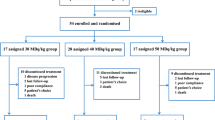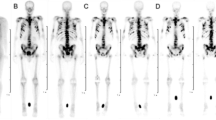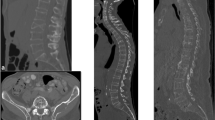Objective:
To evalutate the clinical benefit and mainly to monitor quantitatively the recalcification of osteolytic lesions after radiotherapy with or without intravenous infusion of disodium pamidronate (DP) in different doses.
Patients and Methods: 42 patients with solitary lytic metastasis in weight-bearing bones were studied. Primary endpoints were the mean value and energy of gray-level histogram in plain radiographs (MVGLH and EGLH) and relative electron density (RED) of CT scans in bone lesions. In eleven patients (group A) the DP dose was increased stepwise from 90 up to 180 mg (flat dose), while in other 15 patients (group B) a flat dose of 180 mg was administered intravenously in 2 h. In both groups, the first session of DP was given concurrently with local radiotherapy (30 Gy in ten fractions, 5 days a week). Another 16 patients (group C) underwent radiotherapy only.
Results: Morbidity related to pamidronate was mild. Significant differences from the baseline (p < 0.05, Wilcoxon test) were recorded for MVGLH, EGLH and RED values, regarding all groups. Improvement was significantly higher in patients of group B versus A, while the results of pamidronate groups (A and B) were superior to group C, concerning the above indices (p < 0.05, Mann-Whitney test). Additionally, pamidronate groups had significantly lower skeletal morbidity than group C.
Conclusion: The 2-h infusional flat dose of 180 mg every 4 weeks seems to be tolerable and superior to 90 mg regarding palliation and mainly recalcification of osteolytic lesions. Radiotherapy alone is effective but inferior to the combined treatment. Last but not least, the findings of MVGLH, EGLH and RED indicate an important increase in bone mass and bone formation, which was difficult to be identified visually by the experts.
Ziel:
Quantitative Evaluation klinischer Vorteile und der Rekalzifizierung osteolytischer Läsionen nach Strahlentherapie allein oder in Kombination mit einer intravenösen Infusion von Pamidronat in unterschiedlicher Dosierung.
Patienten und Methodik: 42 an einer solitären osteolytischen Metastase im Bereich der Stammknochen leidende Patienten wurden untersucht. Primäre Endpunkte waren der Mittelwert und die Energie der Graustufenhistogramme in den normalen Röntgenbildern (MVGLH und EGLH) und die relative Elektrondichte (RED) von CT-Aufnahmen im Bereich der knöchernen Läsionen. Bei elf Patienten (Gruppe A) wurde die Pamidronat-Dosis stufenweise von 90 auf 180 mg erhöht, während bei 15 weiteren Patienten (Gruppe B) eine Dosis von 180 mg intravenös in 2 h verabreicht wurde. Beiden Gruppen wurden die ersten Pamidronat-Applikationen gleichzeitig mit der lokalen Strahlentherapie (30 Gy in zehn Fraktionen, 5 Tage pro Woche) verabreicht. Bei weiteren 16 Patienten (Gruppe C) wurde nur bestrahlt.
Ergebnisse: Die mit Pamidronat assoziierte Morbidität war mild. Bedeutende Unterschiede vom Ausgangswert (p < 0,05, Wilcoxon-Test) wurden für MVGLH-, EGLH- und RED-Werte gesehen. Die Verbesserung war bei Patienten der Gruppe B erheblich höher als bei Patienten der Gruppe A, während die Ergebnisse der Pamidronat-Gruppen (A und B) deutlich besser als die der Gruppe C waren. Zusätzlich hatten die Pamidronat-Gruppen eine erheblich niedrigere Morbidität bezüglich des Skelettsystems als Gruppe C.
Schlussfolgerung: Eine 2-stündige Infusion von 180 mg Pamidronat alle 4 Wochen scheint hinsichtlich der Palliation und der Rekalzifizierung osteolytischer Läsionen besser zu sein als die 90-mg-Dosierung. Die Strahlentherapie allein ist weniger wirkungsvoll als die kombinierte Therapie. Die Ergebnisse von MVGLH, EGLH und RED zeigen eine Zunahme der Knochenmasse.
Similar content being viewed by others
Author information
Authors and Affiliations
Additional information
Received: December 10, 2001; accepted: March 24, 2003
Address for Correspondence Vassilis Kouloulias, PhD, Department of Electrical and Computer Engineering, Institute of Communication and Computer Systems, Attention Prof. N. Uzunoglou, National Technical University of Athens, 9 Iroon Polytechneiou St., Zografou, 15773 Athens, Greece, Phone (+30/210) 728 6265, Fax 772 3557, e-mail: vkouloul@cc.ece.ntua.gr
Rights and permissions
About this article
Cite this article
Kouloulias, E., Kouvaris, R., Antypas, C. et al. An Intra-Patient Dose-Escalation Study of Disodium Pamidronate plus Radiotherapy versus Radiotherapy Alone for the Treatment of Osteolytic Metastases . Strahlenther Onkol 179, 471–479 (2003). https://doi.org/10.1007/s00066-003-0978-3
Issue Date:
DOI: https://doi.org/10.1007/s00066-003-0978-3




